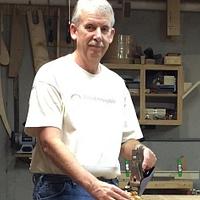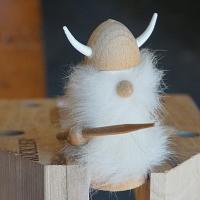
Mike40
in over 11 years
FANTASY MARQUETRY #4: Evolution of the Wizard Design
This is
part 4
in a
13 part
series:
FANTASY MARQUETRY
...
-
Preparing A Packet For Cutting
-
Evolution of the Wizard Design
-
Assembling the packet (at Last)
...
- Preparing A Packet For Cutting
- Evolution of the Wizard Design
- Assembling the packet (at Last)
WARNING An important part of this marquetry, but no woodworking involved.
Since I am attempting to take you on my complete novice journey with this project I have to bring up the subject of the design again, but in more detail this time.
The design for a marquetry is everything. No matter how beautiful the veneers are or how well cut and joined they are, the final project will be judged on the basis of how good the finished picture looks.
You can start out with a very nice photo or drawing, but you will soon discover that converting it into an outline drawing that looks good and is possible to cut might present quite a challenge. That is what I was faced with in working with this wizard painting shown below done by my son Mark.
For this project I used my light table to trace the different renditions of the design and with varying degrees of success. Here are the results and my thoughts as I worked through the process.
The original painting. It looked somewhat challenging, but doable to me. Here is the first tracing I made. Way too much detail! I tried to envision how in the world I would be able to produce veneer patches for all of this! It would take a lot more than the 6 or 7 layers which I was shooting for. I should mention here that packets with over 7 layers are not the best idea because the thicker the pack the more the accuracy suffers. That translates to wider gaps between mating pieces. I got depressed just looking at it and almost gave up the project right then.
I decided that what I needed was an outline and very simplified detail just to clear my head and make the basis for something that I could actually hope to cut, so here is what I came up with next.
Then I found that I could add a little more detail as long as it wasn’t too small, so that was incorporated into the drawing below. Now things were looking up and I began to have hope that I could manage to make a picture (never mind how good it would be).
The drawing above was numbered to correspond with the numbers I assigned the different veneers to be used and I used it to cut the veneer patches which were inserted into 7 layers of poster board ‘wasters’. As I progressed I saw that more detail could be added, but I was pretty close to the limit of veneers that my 7 layers could accommodate.
I decided that I could add the tree bark details a couple of other small things and that would be that. Here is the final cut pattern for the first packet. Please note that I have now identified each piece with a number (unrelated to the veneer ID) so I will know where they belong after being cut.
I may still be able to add a couple more veneer patches to some areas on some of the existing layers, but being new to this technique I feel that this packet is pretty well finished.
My plan is cut the first packet and then assemble the cuttings and use them as one layer in a new packet which will encompass the last details which were omitted in the first cutting or which were added to the drawing afterward.
I know this is pretty boring, but I think it is part of the work and even though I may be making it more difficult than it needs to be it will at least address part of the marquetry process. I hope you find something interesting here. My next blog on this will cover putting the packet together ready for cutting. Thanks for following with.
Mike, an American living in Norway
7 Comments
With all the details you added you almost back to the original in term of complexity :)
Abbas, Castro Valley, CA
Wow Mike, I had no idea the amount of work it takes to do this. Your final sketch turned out well.
Enjoying your journey…
You have more patience than me, my friend. Now let’s get to cutting. ;-)
Losing fingers since 1969
Abbas Yes, I am almost back to a high level of detail, but this time it is something that can be cut. Not fuzzy areas that leave doubt where my saw blade headed. The details in the original have to be made into distinct pieces without destroying the spirit of the picture.
Tim I know it seems time consuming, but I am training myself to forget about time and just enjoy each step of the process. Of course my approach is probably pretty amateurish at this point, but I think having the right attitude will pay off as my skill increases.
Brian It’s a journey. The kids in the back seat keep asking if we are there yet while the adults enjoy the ride. I started woodworking as a turner because I had to have a finished project in an hour or two, but now I know that most well done projects are made up of a series of small successful projects, so I congratulate myself and celebrate after completing each step (any excuse for a party)
Mike, an American living in Norway
No wonder that you have no time for anything else. This looks very complicated, and totally absorbing. Good luck. I can’t wait for the final result.
Tor and Odin are the greatest of gods.
Ah, Mike you are a man after my own heart.
There’s just no thrill in starting out slow. The deep end is the only place to start.
We really seem to agree on that.
Your level of detail is high but eminently do-able (with a chevalet) and with your determination it shall be done ……… and I’m betting, very well done.
The early bird gets the worm but its the second mouse that gets the cheese.
Madts If I get it finished too fast then I’ll suffer from postpartum depression. This way I’ll be tired of looking at it and glad it’s finally done at the end.
Paul I’m just following your lead.
Mike, an American living in Norway













